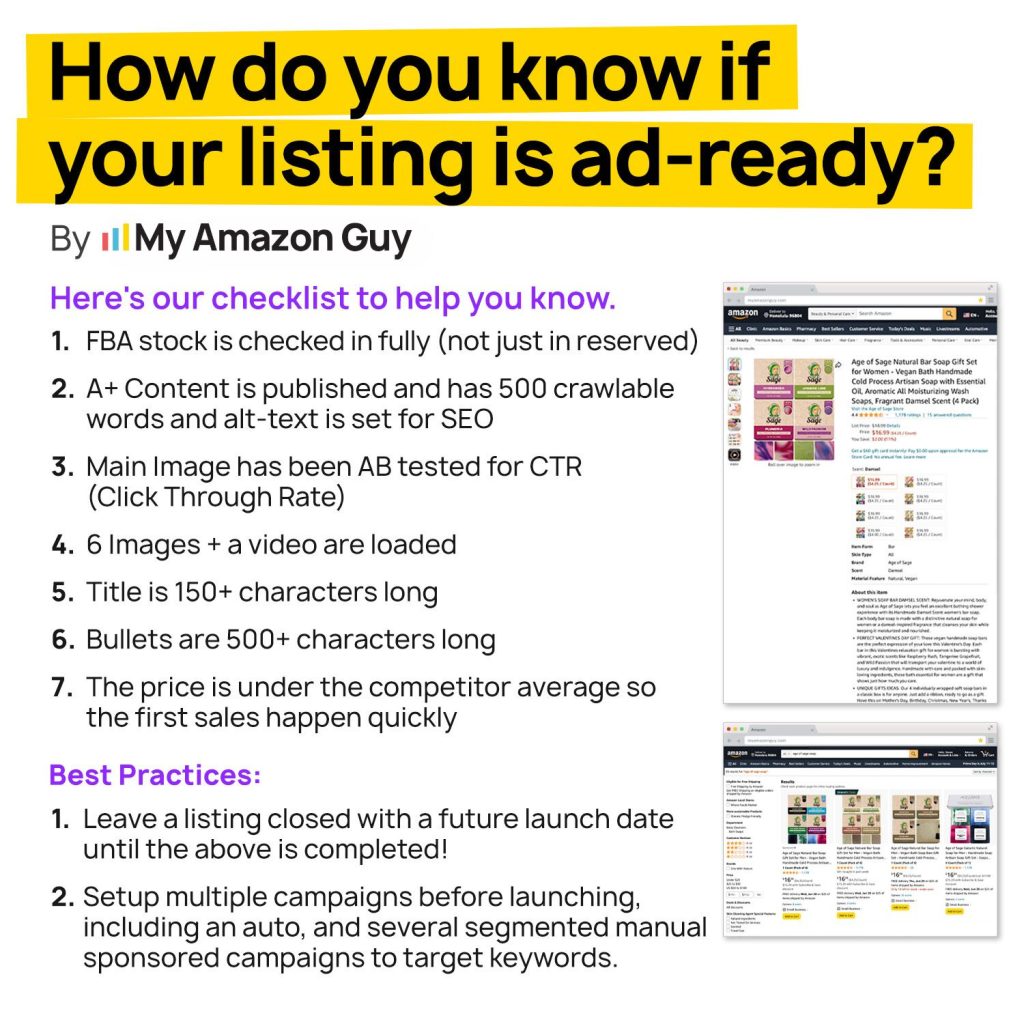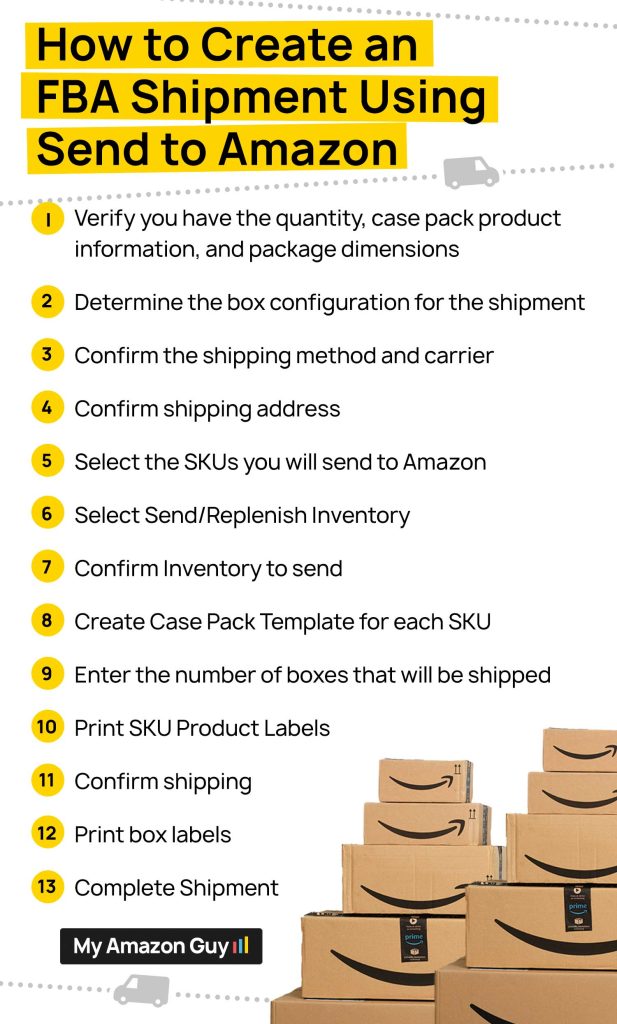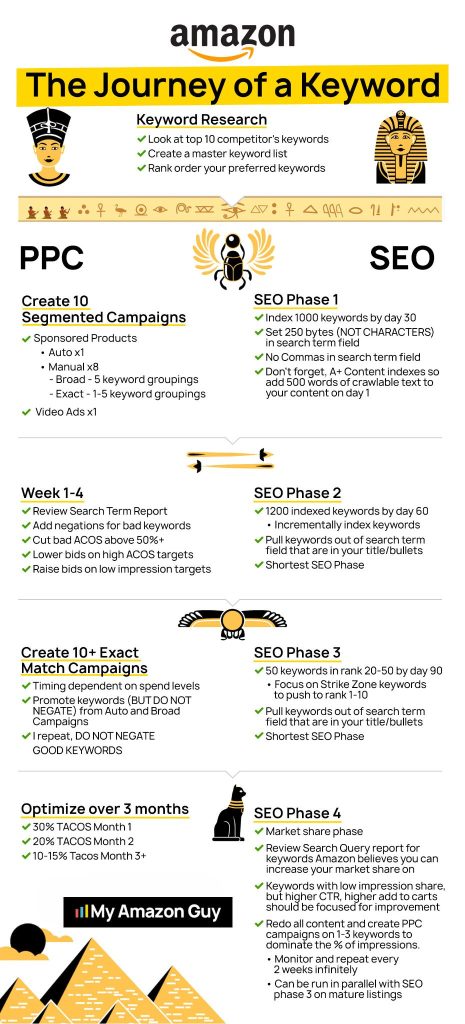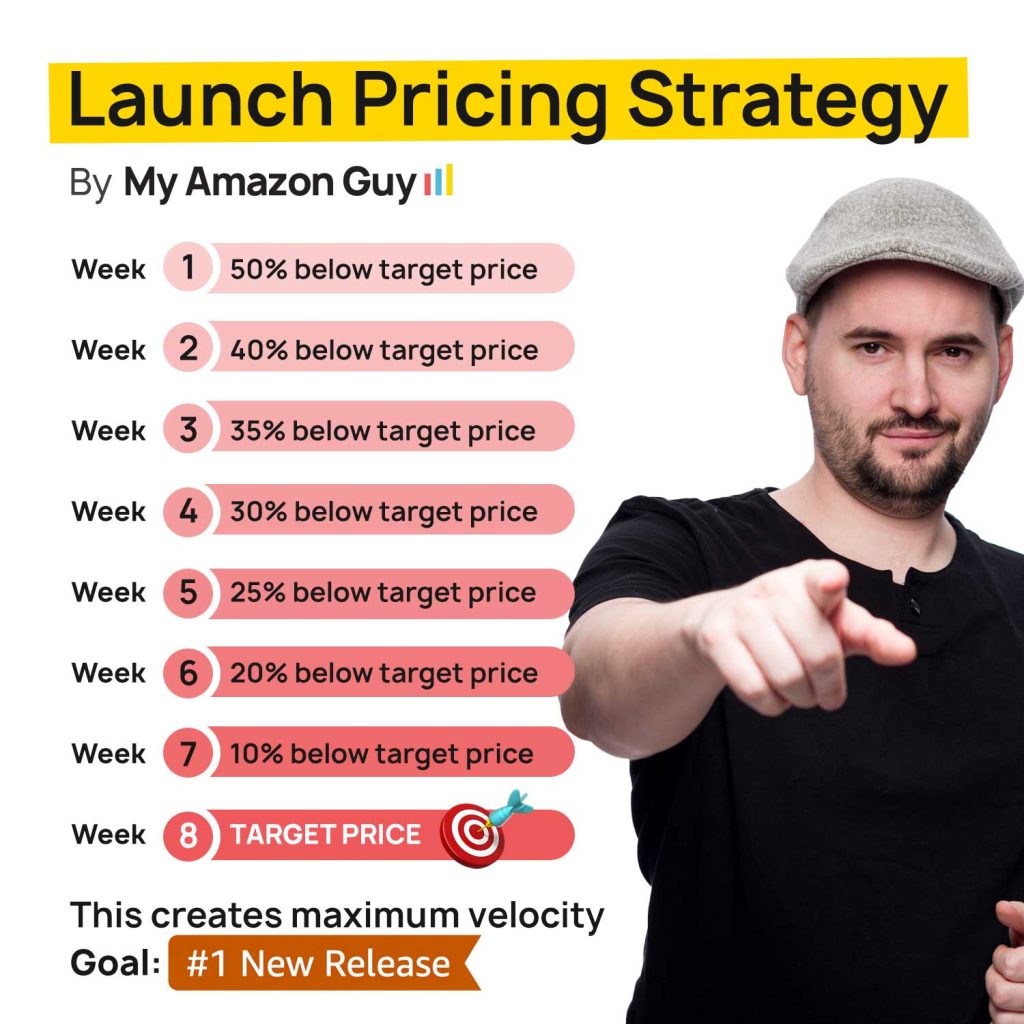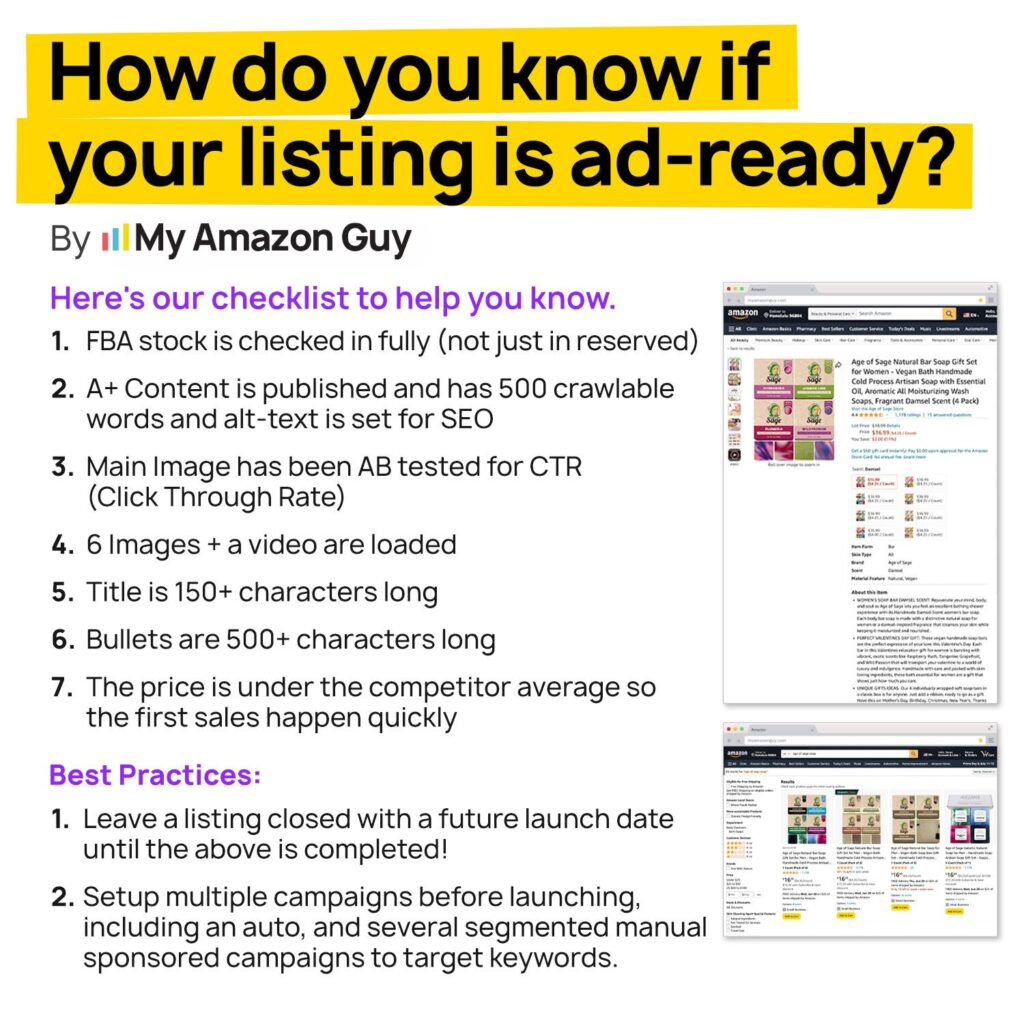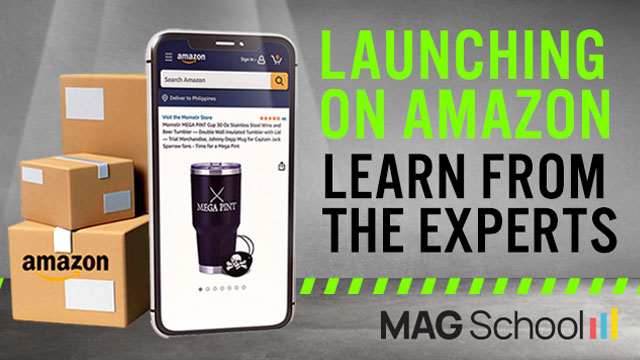Launching Products on Amazon
14 Doable Steps To Refine Your Amazon Launch Strategy
Launching your product on Amazon demands a well-crafted strategy that goes beyond mere product placement. A strategic launch not only enhances visibility but also establishes a positive first impression, crucial for standing out in the competitive marketplace.
We don’t want to delay your success, so let’s quickly delve into the 14 steps you can take for a better Amazon Launch Strategy.
Here are the 14 steps for launching products on Amazon:
- Step 1: Product Research and Planning
- Step 2: Search For Suitable Keywords
- Step 3: Create Your Product Listing
- Step 4: Set The Launch Dates
- Step 5: Send Stocks To Amazon
- Step 6: Optimize Listing
- Step 7: Set Up PPC Campaigns
- Step 8: Plan Your Pricing Strategy
- Step 9: Manage and Monitor Your Inventory
- Step 10: Gather Customer Reviews
- Step 11: Set Promotions and Discounts
- Step 12: Monitor Performance and Analytics
- Step 13: Implement Ongoing Optimization
- Step 14: Manage Customer Relationship
- Conclusion
Amazon Launch Strategy: Step 1
Product Research and Planning
Product Selection: Identify a product with high demand and low competition.
Before you even begin to craft your Amazon launch strategy, it’s crucial to make an informed product selection. This initial step sets the foundation for your entire launch and determines your chances of success in the competitive Amazon marketplace.
To identify products with high demand and low competition, consider the following factors:
A. Demand Analysis
- Search Volume: Utilize keyword research tools to assess the search volume for potential products. High search volume indicates strong demand from potential customers.
- Sales Estimates: Employ sales estimation tools to gauge the approximate monthly sales volume of similar products. This provides insights into the overall market size and demand potential.
B. Competition Assessment
- Number of Sellers: Analyze the number of sellers offering similar products on Amazon. A lower number of sellers suggests less competition, making it easier to stand out and gain market share.
- Seller Reviews: Evaluate the quality and quantity of seller reviews for competing products. Positive reviews indicate satisfied customers, while negative reviews suggest product or service issues.
- Product Differentiation: Identify unique selling points (USPs) that differentiate your product from competitors. These USPs could be innovative features, superior quality, or exclusive benefits.
C. Profitability Potential
- Profit Margin: Estimate the profit margin for your potential product, considering factors like product cost, manufacturing expenses, and Amazon fees. Ensure the profit margin aligns with your business goals.
- Product Lifespan: Assess the product’s lifespan and potential for long-term sustainability. Avoid products with short trend cycles or limited demand.
Target Market Analysis: Understand your ideal customer’s demographics, interests, and needs.
In the competitive landscape of Amazon, where millions of products vie for attention, understanding your target market is paramount to success. A well-defined target market allows you to tailor your messaging, product selection, and marketing strategies, maximizing your chances of resonating with potential customers.
To effectively identify your ideal customer, embark on a thorough target market analysis, delving into the following aspects:
A. Demographics
- Age: Identify the age range of your target customers, considering their purchasing power, preferences, and online behavior.
- Gender: Determine whether your product appeals primarily to males, females, or both. This helps tailor your marketing messages and product positioning.
- Location: Identify the geographic regions where your target customers reside, considering regional preferences, market trends, and shipping costs.
B. Interests
- Hobbies and Passions: Understand what your target customers enjoy doing in their free time. This helps identify relevant interests and align your product with their lifestyle.
- Online Behaviors: Analyze your target customers’ online behavior, including their preferred social media platforms, websites they frequent, and online shopping habits.
- Lifestyle and Values: Understand your target customers’ lifestyle choices, values, and aspirations. This helps tailor your messaging and connect with them on a deeper level.
C. Needs and Pain Points
- Common Problems: Identify the pain points and problems your target customers face daily. Your product should address these issues and provide a solution.
- Desired Solutions: Understand what solutions your target customers are seeking to address their pain points. Position your product as the answer to their problems.
- Aspirations and Goals: Determine the aspirations and goals your target customers strive to achieve. Your product should align with their desires and help them achieve their objectives.
Product Differentiation: Develop a unique selling proposition that sets your product apart from competitors.
In the bustling marketplace of Amazon, where similar products abound, standing out from the crowd is essential for success. Developing a unique selling proposition (USP) is your key to differentiating your product and capturing the attention of potential customers.
A compelling USP clearly articulates the distinctive qualities and advantages that set your product apart from competitors. It should highlight the unique benefits your product offers and explain why customers should choose you over alternatives.
To craft a powerful USP, consider the following steps:
- Identify Your Competitors: Conduct thorough research to understand your competitors’ products, pricing, and marketing strategies. This will help you identify gaps in the market and opportunities for differentiation.
- Analyze Customer Needs and Pain Points: Understand the specific needs and pain points of your target customers. Your USP should address these concerns and provide a solution that resonates with them.
- Focus on Unique Features and Benefits: Highlight the unique features and benefits that make your product stand out. These could be innovative features, superior quality, exceptional customer service, or exclusive warranties.
- Communicate Your USP Clearly: Craft a concise and compelling statement that clearly communicates your USP. Use simple language, avoid jargon, and emphasize the value your product offers to customers.
- Incorporate USP into Marketing Efforts: Integrate your USP into your product listing, product descriptions, marketing materials, and social media messaging. Ensure your USP is consistently communicated across all channels.
Amazon Launch Strategy: Step 2
Search For Suitable Keywords
Keyword Identification: Find relevant keywords that potential customers are using to search for similar products.
In the vast expanse of Amazon’s marketplace, keywords serve as the keys that unlock the door to product visibility and customer discovery. By identifying and strategically incorporating relevant keywords throughout your product listing, you can effectively connect your products with potential customers seeking similar items.
Understanding Keyword Significance
Keywords are the search terms that potential customers use when browsing or actively searching for products on Amazon. As customers type in keywords, Amazon’s search algorithm matches those terms with relevant product listings. By identifying the keywords that align with your product’s features, benefits, and target audience, you can ensure that your product appears prominently in search results, increasing its chances of being seen and purchased.
Unveiling Keyword Treasure Troves
To identify the right keywords for your product, embark on a keyword research journey. Utilize Amazon’s native keyword research tools, such as the Search Term Reports and Keyword Explorer, to gain insights into the frequently used keywords related to your product category. Additionally, explore competitor listings, customer reviews, and industry trends to uncover additional relevant keywords.
Keyword Analysis and Prioritization
Once you’ve gathered a substantial list of potential keywords, it’s time to prioritize them based on their relevance, search volume, and competition. Amazon’s keyword research tools provide valuable metrics, such as search volume and suggested keywords, to guide your selection. Prioritize keywords that are highly relevant to your product, have moderate to high search volume, and face manageable competition.
Keyword Integration and Optimization
Strategically integrate your chosen keywords throughout your product listing, including the title, description, bullet points, and A+ content. Ensure that keyword usage is natural and relevant to the product’s context, avoiding keyword stuffing that can negatively impact search rankings.
Keyword Monitoring and Refinement
Keyword research and optimization is an ongoing process. Regularly monitor your keyword performance using Amazon’s analytics tools to identify which keywords are driving traffic and conversions. Adapt your keyword strategy based on these insights, adding new relevant keywords and refining the placement of existing ones.
Keyword Research Tools: Your Allies in Search Success
Amazon offers a suite of keyword research tools to aid your keyword identification journey:
- Search Term Reports: Provides insights into the keywords that customers used to find your products.
- Keyword Explorer: Suggests relevant keywords based on your product category and search terms.
- Amazon Brand Analytics: Offers in-depth keyword analysis for brands with Amazon Brand Registry.
Keyword Placement: Strategically incorporate keywords into your product title, description, bullet points, and backend search terms.
Keyword placement is the art of strategically incorporating relevant keywords throughout your Amazon product listing to enhance product visibility and attract potential customers. By placing keywords thoughtfully in key areas of your listing, you can increase the likelihood of your product appearing in relevant search results when customers are browsing or actively searching for similar items.
Keyword Monitoring: Track your keyword performance and make adjustments as needed.
Keyword monitoring is an essential practice to ensure your product listings remain relevant and visible to potential customers. By tracking the performance of your chosen keywords, you can gain valuable insights into their effectiveness, identify areas for improvement, and make data-driven adjustments to your keyword strategy.
Amazon Launch Strategy: Step 3
Create Your Product Listing
Creating a listing on Amazon is the process of adding your product to Amazon’s catalog so that it can be seen and purchased by potential customers. A listing includes all of the information that customers need to know about your product, such as its title, description, price, and images.
Here are the three most important things to remember when creating an Amazon listing, based on the provided information:
Selecting the Right Category
- Identify the most relevant category for your product by conducting competitive research. Consider where your competitors are listed and choose the category that aligns with your product. This ensures your listing is visible to the right audience.
Creating a Compelling Product Title
- Craft an engaging product title that will appear on the live product page. Include your brand name and key details about the product. This initial information is crucial for attracting potential buyers and making your listing stand out.
Setting Up a Detailed Skeleton Listing
- Create a skeleton listing by entering essential information such as the product identifier, brand name, SKU (Stock Keeping Unit), condition (e.g., new), and fulfillment method (FBA or FBM). This enables you to generate an ASIN (Amazon Standard Identification Number) and initiate the process of sending products to FBA or listing them for merchant fulfillment. Additionally, having a well-defined SKU naming convention is recommended for better inventory management.
You’re likely familiar with MAG School, My Amazon Guy’s premier learning platform that offers a range of courses to elevate your Amazon expertise.
One of our flagship courses is Launching on Amazon, where you’ll gain the knowledge and skills to successfully launch products on Amazon and earn a certificate upon completion.
If you’ve been an active follower of our MAG School LinkedIn page, you’ve probably participated in our Microlearning course. For those who missed this valuable series, we’ll be incorporating its segments into this comprehensive guide.
Feel free to take the mini-assessment in each micro-course lesson. Here’s the first installment:
For additional tips on creating a product detail page, watch this video from our Youtube channel.
Amazon Launch Strategy: Step 4
Set The Launch Dates
To ensure a smooth and successful product launch on Amazon, it’s crucial to establish strategic launch dates that align with your product’s readiness, marketing efforts, and Amazon’s internal calendar. Here’s a breakdown of the key launch dates:
1. Launch Date
The launch date marks the official debut of your product on Amazon. Customers will begin seeing your product listing and can start adding it to their wishlists or carts. Setting a launch date in the future allows ample time for thorough planning and preparation, ensuring that all essential elements, such as product images, descriptions, and inventory, are in place before the product becomes available for purchase.
2. Release Date
The release date signifies the moment when customers can finally purchase your product from Amazon. This date should align with your product’s readiness and ensure that your listing is complete and optimized for search. A future release date provides an opportunity to build anticipation and excitement around your product, enabling you to plan effective marketing campaigns, promotions, and other strategies to maximize the impact of your launch.
3. Offer Date
The offer date, also known as the promotional start date, marks the commencement of any special offers or deals associated with your product. This could include discounts, bundled promotions, or other incentives to attract customers and boost sales. Setting a future offer date allows you to prepare inventory, plan marketing initiatives, and coordinate backend operations to ensure a smooth and successful promotional period.
Establishing both launch and release dates offers several benefits:
- Avoid Customer Confusion: By clearly separating the launch date (when the product becomes visible) from the release date (when it’s available for purchase), you prevent customer confusion and ensure that customers have accurate expectations regarding product availability.
- Ensure a Successful Launch: Setting a future launch date gives Amazon ample time to create a placeholder image for the product and ensure that all necessary content is fully prepared before the product goes live.
- Prepare for Inventory and Marketing: A future offer date allows you to properly manage inventory levels, plan targeted marketing campaigns, and coordinate backend operations in anticipation of increased demand during the promotional period.
- Generate Anticipation and Excitement: By strategically timing your launch and release dates, you can build anticipation and excitement among potential customers, leading to a more impactful product launch.
- Maximize Marketing Effectiveness: A well-planned launch and release strategy enables you to align your marketing efforts with the product’s availability, ensuring that your promotional messages reach customers at the right time to drive sales.
Amazon Launch Strategy: Step 5
Send Stocks To Amazon
Sending stock to Amazon is a crucial step in the product launch process, as it ensures that your products are available for purchase and ready to meet customer demand. The process involves creating a shipping plan, preparing your inventory, and coordinating with Amazon’s fulfillment centers. Here’s a comprehensive guide to sending stocks to Amazon effectively.
Creating a Shipping Plan
- Determine Your Shipping Method: Decide whether you’ll use Fulfillment by Amazon (FBA) or Merchant Fulfillment (FBM). FBA entails sending your inventory to Amazon’s fulfillment centers, while FBM involves fulfilling orders yourself. Checkout this blog post for a comprehensive comparison between FBA and FBM.
- Establish a Shipping Plan: Utilize Amazon’s Shipping Queue to create a shipping plan, specifying the quantity of each product you intend to send. This plan helps Amazon anticipate your inventory arrival and allocate space accordingly.
- Generate Shipping Labels: Generate shipping labels for each shipment, ensuring accurate product and quantity information. These labels will guide your inventory to the designated Amazon fulfillment centers.
Preparing Your Inventory
- Label and Package Products: Clearly label each product with its unique barcode or identifier, ensuring easy identification during receiving and storage. Package your products securely to protect them from damage during transit.
- Pallet Your Inventory: If sending large quantities, consider palletizing your products to streamline receiving and storage at Amazon’s fulfillment centers. Palletizing ensures efficient handling and reduces the risk of product damage.
- Adhere to Amazon’s Packaging Guidelines: Strictly follow Amazon’s packaging guidelines, including box dimensions, weight limits, and labeling requirements. Proper packaging ensures seamless processing and reduces the risk of inventory delays or rejections.
Coordinating with Amazon’s Fulfillment Centers
- Schedule Shipping Appointments: Schedule shipping appointments with Amazon’s fulfillment centers to ensure timely delivery and avoid congestion. Appointments help Amazon plan for receiving and processing your inventory efficiently.
- Track Your Shipments: Utilize Amazon’s shipment tracking tools to monitor the movement of your inventory from your location to Amazon’s fulfillment centers. This tracking provides visibility and alerts you to any potential delays or issues.
- Resolve Shipment Discrepancies: Promptly address any discrepancies in shipment quantity or condition upon arrival at Amazon’s fulfillment centers. Timely resolution ensures accurate inventory tracking and prevents delays in product availability.
While it depends on your particular needs and circumstances whether to use FBA or FBM, the fourth lesson in our microlearning course focuses on FBA logistics. To know more, here’s the post you can read.
Amazon Launch Strategy: Step 6
Optimize Listing
To increase your likelihood of earning more profits from the products you launch on Amazon, make sure you do not underestimate the power of listing optimization.
Listing optimization is highly important when launching a product on Amazon for several reasons:
- Improved Product Visibility: A well-optimized product listing increases the likelihood of your product appearing in relevant search results when customers are browsing or searching for similar items. This enhances product visibility and attracts potential customers to your listing.
- Enhanced Click-Through Rates: A compelling and informative product listing encourages customers to click on your product page, rather than scrolling past it. This improves click-through rates (CTRs), leading to more traffic to your listing and increased opportunities for sales.
- Boosted Conversion Rates: An optimized product listing that effectively communicates the product’s value proposition and addresses customer needs can increase the chances of visitors converting into buyers. This translates to higher conversion rates and improved sales performance.
- Reduced Advertising Costs: By optimizing your product listing to rank higher in organic search results, you can reduce your reliance on paid advertising, such as PPC (pay-per-click) campaigns. This can save you money on advertising costs and improve your overall profitability.
- Enhanced Brand Reputation: A well-crafted and informative product listing that showcases your brand’s professionalism and attention to detail can enhance your brand reputation among customers. This can lead to increased brand trust and loyalty, which can benefit your overall business.
- Competitive Advantage: In the competitive Amazon marketplace, a well-optimized product listing can give you a significant edge over your competitors. By standing out from the crowd, you can attract more customers and achieve greater sales success.
- Sustainable Growth: Optimizing your product listings is an ongoing process that should continue throughout the product’s lifecycle. By regularly reviewing and refining your listings, you can maintain a competitive advantage and drive long-term growth for your products on Amazon.
Amazon Launch Strategy: Step 7
Set Up PPC Campaigns
- Increased Brand Awareness and Visibility: PPC campaigns help boost your product’s visibility on Amazon, particularly during the crucial launch phase when it’s competing for attention amidst millions of other products. By placing ads on product detail pages, search results, and other relevant locations, you can bring your product to the forefront of potential customers’ searches.
- Targeted Traffic and Improved Product Discovery: PPC campaigns allow you to target your ads to specific audiences based on their demographics, interests, purchase history, and browsing behavior. This targeted approach ensures that your ads reach the right people, increasing the likelihood of attracting potential customers who are genuinely interested in your product.
- Enhanced Sales and Revenue Generation: By driving targeted traffic to your product listings, PPC campaigns can directly contribute to increased sales and revenue. As more potential customers discover your product through ads, the chances of them making a purchase increase, leading to a boost in sales.
- Accelerated Product Launch and Market Penetration: PPC campaigns can accelerate your product launch and penetrate the market more quickly. By gaining early visibility and attracting potential customers from the start, you can establish a strong product presence and gain traction before competitors catch up.
- Valuable Data and Insights for Product Optimization: PPC campaigns provide valuable data and insights into customer behavior, search trends, and competitor strategies. By analyzing campaign performance metrics, you can gain a deeper understanding of your target audience, identify top-performing keywords, and optimize your product listing accordingly.
- Competitive Advantage in a Dynamic Marketplace: Amazon is a highly competitive marketplace where organic product visibility can be challenging to achieve, especially for new products. PPC campaigns provide a level playing field, allowing you to compete effectively and stand out from the crowd, even as a new entrant.
- Cost-Effective Advertising with Measurable Results: PPC advertising on Amazon offers a cost-effective way to reach your target audience and drive results. You only pay when someone clicks on your ad, and you can set daily and lifetime budget limits to control your spending.
- Define Your PPC Goals Before diving into campaign creation, clearly establish your PPC objectives. Are you aiming to increase brand awareness, generate leads, or drive immediate sales? Having clear goals will guide your campaign strategy and help you measure success.
- Select the Right PPC Campaign Types
Amazon offers various PPC campaign types, each with its strengths and purposes. For product launches, consider the following options:
- Sponsored Products: These ads appear on product detail pages and search results, showcasing your products to potential customers actively searching for related items.
- Product Display Ads: These ads are visually appealing and target shoppers based on their browsing behavior and interests, making them suitable for brand awareness and product discovery.
- Video Ads: Utilize video ads to capture attention, showcase product features, and engage potential customers with a more immersive experience.
- Conduct Thorough Keyword Research Keyword research is crucial for effective PPC campaigns. Identify relevant keywords that potential customers might use to search for your product. Use Amazon’s keyword research tools and analyze competitor listings to find high-volume, low-competition keywords.
- Set Competitive Bids Bidding determines the cost-per-click (CPC) you’re willing to pay for each ad placement. Start with conservative bids and gradually increase them as you assess campaign performance. Monitor your average customer acquisition cost (CAC) to ensure it remains profitable.
- Optimize Ad Placement and Targeting Leverage Amazon’s targeting options to precisely deliver your ads to the right audience. Target by product category, customer demographics, interests, and purchase history to maximize ad relevance and conversion rates.
- Monitor and Optimize Campaign Performance Regularly monitor your PPC campaign performance using Amazon’s reporting tools. Track metrics such as impressions, clicks, conversion rates, and sales to identify areas for improvement. Adjust bids, keywords, and targeting as needed to optimize campaign effectiveness.
- Utilize Amazon’s Advertising Tools Amazon offers various advertising tools to enhance your PPC campaigns. Utilize Amazon Brand Registry to protect your brand and access exclusive advertising features. Experiment with Amazon Attribution to track the effectiveness of your PPC campaigns across multiple touchpoints.
- Consider Professional PPC Management If you lack the time or expertise to manage PPC campaigns effectively, consider outsourcing to a professional Amazon PPC agency. They can provide strategic guidance, optimize campaigns, and help you achieve your PPC goals.
Amazon Launch Strategy: Step 8
Plan Your Pricing Strategy
Gradual Price Reductions: Building Anticipation and Momentum
Embark on a journey of gradual price reductions, starting with a significant discount in week one, approximately 50% below the target price. This initial discount sparks interest, generates buzz, and encourages early adopters to embrace your product. With each subsequent week, progressively reduce the discount, creating a sense of urgency and anticipation among potential buyers.
Week 1: 50% Discount
- Ignite Interest: Capture attention and attract initial sales with a substantial discount.
- Generate Buzz: Fuel word-of-mouth marketing as early adopters share their positive experiences.
- Establish Momentum: Gain traction and build positive sales momentum for the weeks to come.
Week 2: 40% Discount
- Sustain Interest: Maintain the momentum generated in week one with a continued discount.
- Encourage More Sales: Attract a wider audience with an appealing price point.
- Solidify Position: Reinforce your product’s value proposition and strengthen its market position.
Week 3: 35% Discount
- Maintain Engagement: Keep customers engaged with an ongoing price reduction strategy.
- Drive Conversions: Encourage more potential buyers to convert into actual purchasers.
- Establish Credibility: Build trust and credibility as your product gains traction and positive reviews.
Week 4: 30% Discount
- Broaden Appeal: Expand your customer base with an enticing price point.
- Accelerate Sales: Drive accelerated sales and increase product visibility.
- Strengthen Market Presence: Establish a strong presence in your product category.
Week 5: 25% Discount
- Maximize Velocity: Reach peak product velocity, attracting a large number of customers.
- Generate Reviews: Encourage more customer reviews, further fueling positive word-of-mouth.
- Solidify Best Seller Status: Pave the way for achieving the “Newest Best Seller” badge.
Week 6: 20% Discount
- Maintain Momentum: Sustain the high sales momentum achieved in previous weeks.
- Capture Market Share: Capture a significant portion of the market share in your product category
Here are additional videos to watch if you want to learn more about pricing:
Amazon Launch Strategy: Step 9
Manage and Monitor Your Inventory
Demand Forecasting: Estimate product demand to ensure adequate inventory levels.
Demand forecasting plays a pivotal role in ensuring optimal inventory management. By accurately estimating product demand, you can strike a delicate balance between stockouts, which can lead to lost sales and customer dissatisfaction, and excess inventory, which ties up capital and incurs storage costs.
The Significance of Demand Forecasting
Demand forecasting provides several critical benefits for your Amazon product launch strategy:
- Prevent Stockouts: Accurately predict demand to avoid stockouts, ensuring product availability and preventing missed sales opportunities.
- Optimize Inventory Costs: Minimize excess inventory, reducing storage costs and freeing up capital for other business needs.
- Enhance Customer Satisfaction: Maintain consistent product availability, fostering customer satisfaction and loyalty.
- Support Scalability: Enable informed decisions regarding future inventory replenishment and product expansion.
Demand Forecasting Approaches: Unraveling the Future of Demand
Several demand forecasting approaches can be employed to predict product demand:
- Historical Sales Data: Analyze historical sales data to identify trends, seasonality, and patterns.
- Industry Trends: Consider industry trends, market conditions, and competitor activities to assess overall demand.
- Product Lifecycle: Factor in the product’s lifecycle stage, considering the introductory, growth, maturity, and decline phases.
- Marketing Campaigns: Anticipate increased demand driven by marketing campaigns, promotions, and special offers.
- External Factors: Consider external factors such as economic conditions, consumer behavior, and technological advancements.
Inventory Monitoring: Regularly track inventory levels and replenish stock as needed to avoid stockouts.
Inventory monitoring provides several critical benefits for your Amazon product launch strategy:
- Prevent Stockouts: Timely inventory monitoring enables you to identify potential stockouts before they occur, preventing lost sales and customer dissatisfaction.
- Optimize Replenishment: Proactive inventory monitoring allows you to plan and execute replenishment orders efficiently, ensuring adequate stock levels without overstocking.
- Reduce Storage Costs: By minimizing excess inventory, you can reduce storage costs and free up capital for other business needs.
- Enhance Customer Satisfaction: Consistent product availability fosters customer satisfaction, leading to positive reviews, repeat purchases, and brand loyalty.
For further reading about inventory management, here are some articles for you:
Amazon Launch Strategy: Step 10
Gather Customer Reviews
Gathering customer reviews is crucial when launching a product on Amazon for several reasons:
- Boost Product Visibility: Positive customer reviews significantly enhance product visibility in Amazon’s search results and recommendation algorithms. The more positive reviews a product accumulates, the higher it ranks in search results, increasing the likelihood of potential customers discovering and purchasing it.
- Build Trust and Credibility: Customer reviews serve as social proof, influencing the purchasing decisions of other potential buyers. Positive reviews establish trust and credibility, reassuring customers that the product is worth their time and money.
- Enhance Product Perception: Positive reviews highlight the product’s strengths, features, and benefits, shaping customer perception and influencing their purchasing decisions. Reviews can effectively address customer concerns, showcase product value, and differentiate your product from competitors.
- Improve Product Quality and Customer Satisfaction: Gathering customer feedback through reviews provides valuable insights into customer satisfaction levels, product performance, and areas for improvement. By addressing customer concerns and implementing product refinements based on feedback, you can enhance product quality and overall customer satisfaction.
- Drive Organic Traffic and Sales: Positive customer reviews attract organic traffic to your product listing, encouraging potential buyers to click on your product and learn more. Positive reviews can significantly boost conversion rates, leading to increased sales and revenue.
- Establish Brand Reputation: Accumulating positive customer reviews over time helps establish a strong brand reputation on Amazon. A consistent stream of positive reviews reinforces brand trust, loyalty, and customer advocacy.
- Gain Competitive Edge: In the competitive Amazon marketplace, positive customer reviews can give you a significant edge over your competitors. Positive reviews can differentiate your product, attract more customers, and drive sales success.
Provide Incentives: Offer incentives, such as discounts or free products, in exchange for honest reviews.
Offering incentives, such as discounts or free products, in exchange for honest reviews can be a double-edged sword. While it can encourage more customers to leave reviews, it can also lead to biased reviews that may not accurately reflect the product’s quality or performance.
On one hand, offering incentives can increase the likelihood of receiving reviews, especially from customers who may not have otherwise taken the time to leave feedback. This can be particularly beneficial for new products that have not yet accumulated many reviews. Additionally, providing incentives can encourage more detailed and thoughtful reviews, as customers may feel more compelled to provide a thorough assessment of the product in exchange for the reward.
However, offering incentives for reviews raises concerns about the authenticity and objectivity of the feedback. Customers who receive incentives may be more inclined to leave positive reviews, even if their experience with the product was not entirely satisfactory. This can mislead potential buyers and distort the overall perception of the product’s quality.
Moreover, Amazon has strict guidelines against offering incentives for reviews, and violating these guidelines can result in penalties, including the removal of reviews and even suspension of your seller account. To ensure compliance with Amazon’s policies, it is crucial to clearly disclose any incentives offered for reviews and to avoid any language that suggests that customers are expected to leave positive reviews in exchange for the reward.
Monitor Reviews: Respond promptly to both positive and negative reviews to demonstrate customer care.
Monitoring and responding to customer reviews, both positive and negative, is crucial for building trust, demonstrating customer care, and maintaining a positive brand reputation on Amazon. Here’s a comprehensive guide to effectively handling customer reviews:
Responding to Positive Reviews:
- Express Gratitude: Thank customers for their positive feedback and appreciation of your product. Acknowledge their satisfaction and highlight the positive aspects of their experience.
- Reinforce Brand Values: Align your responses with your brand’s values and messaging. Showcasing customer satisfaction reinforces your commitment to providing excellent products and services.
- Encourage Further Engagement: Invite customers to continue engaging with your brand by following social media pages, subscribing to newsletters, or exploring other products.
- Humanize Your Response: Personalize your responses by using the customer’s name and addressing their specific points of satisfaction. Avoid generic, template-like responses.
Responding to Negative Reviews:
- Acknowledge Concerns: Promptly respond to negative reviews, expressing empathy and acknowledging the customer’s concerns. Avoid defensiveness or excuses.
- Apologize for Dissatisfaction: Sincerely apologize for any inconvenience or dissatisfaction the customer experienced. Take ownership of any shortcomings or issues.
- Address Concerns Directly: Address specific issues raised in the review, providing explanations, solutions, or compensation as appropriate.
- Offer Assistance: Propose solutions or offer assistance to resolve the customer’s concerns. Show your willingness to make amends and improve their experience.
- Prevent Recurrence: Use negative feedback as an opportunity to identify and address systemic issues within your product or service offerings.
Additional Tips:
- Respond Consistently: Respond to all reviews, both positive and negative, within a reasonable timeframe. Consistent responsiveness demonstrates your commitment to customer care.
- Maintain Professionalism: Use a professional and respectful tone, even when addressing negative feedback. Avoid emotional responses or personal attacks.
- Utilize Amazon’s Review Manager: Leverage Amazon’s Review Manager tool to organize, track, and respond to customer reviews efficiently.
- Monitor Review Sentiment: Track overall review sentiment using Amazon’s analytics tools to identify areas for improvement and address customer concerns promptly.
Amazon Launch Strategy: Step 11
Set Promotions and Discounts
Lightning Deals: Participate in Lightning Deals to generate short-term sales spikes and boost visibility.
Lightning Deals are limited-time, high-discounted promotions that feature a limited number of units of a specific product at a significantly reduced price. These deals are displayed prominently on Amazon’s homepage, dedicated Lightning Deals pages, and relevant product listings, capturing the attention of a large audience.
Benefits of Lightning Deals:
- Short-Term Sales Boost: Generate immediate sales spikes, particularly during peak shopping periods, such as holiday seasons.
- Increased Product Visibility: Gain exposure to a wider audience, increasing product visibility and attracting new potential customers.
- Enhanced Brand Awareness: Elevate brand awareness and recognition among Amazon shoppers.
- Improved Product Rankings: Boost product rankings in search results and category pages, leading to increased organic traffic.
- Inventory Clearance: Effectively clear out excess inventory, making way for new products or variants.
Eligibility for Lightning Deals:
To participate in Lightning Deals, your product must meet certain eligibility criteria:
- Selling Fulfilled by Amazon (FBA): Your product must be enrolled in Amazon’s FBA fulfillment program.
- New or Improved Condition: Your product must be in new or improved condition and have a minimum of 100 positive customer reviews.
- Competitive Pricing: Your product’s price must be competitive within its category and have a sufficient discount margin for a Lightning Deal.
- Sufficient Inventory: You must have adequate inventory to meet the anticipated demand during the Lightning Deal.
Optimizing Lightning Deal Participation:
To maximize the effectiveness of your Lightning Deal participation, follow these strategies:
- Select the Right Products: Choose products that are well-reviewed, have strong demand, and are suitable for discounting.
- Set an Attractive Discount: Offer a significant discount that incentivizes customers to purchase during the limited-time deal.
- Choose an Optimal Deal Duration: Select a deal duration that aligns with your product’s demand and inventory levels.
- Utilize Promotional Tools: Leverage Amazon’s promotional tools, such as coupons and vouchers, to further enhance deal attractiveness.
- Prepare for Post-Deal Surge: Anticipate an increase in sales and customer inquiries following the Lightning Deal, and ensure your customer service is well-equipped to handle the surge.
Monitoring Lightning Deal Performance:
After your Lightning Deal, track its performance using Amazon’s analytics tools to assess its effectiveness and identify areas for improvement. Analyze metrics such as sales volume, conversion rates, and customer feedback to gain valuable insights.
Coupons and Promotions: Offer coupons and promotions to attract new customers and encourage repeat purchases.
Here are some of the types of coupons and promotions that you can use on Amazon:
- Percentage-off coupons: These coupons offer a fixed percentage discount on the product’s price. For example, you could offer a 20% off coupon on your product.
- Money-off coupons: These coupons offer a specific dollar amount discount on the product’s price. For example, you could offer a $10 off coupon on your product.
- Buy-one-get-one (BOGO) promotions: These promotions offer a discounted or free product with the purchase of another. For example, you could offer a BOGO 50% off promotion on your product.
- Limited-time discounts: These discounts are only available for a limited time, such as 24 hours or a weekend sale. This can create a sense of urgency and encourage customers to purchase immediately.
- Free shipping promotions: These promotions offer free shipping to customers who reach a certain purchase threshold. This can make your products more attractive to customers, especially those who live far away from your fulfillment center.
Here are some tips for optimizing your coupon and promotion usage:
- Target specific customer segments: Tailor your coupons and promotions to specific customer groups, such as first-time buyers, loyal customers, or those with abandoned carts. This will help you get the most out of your promotions.
- Set clear promotion terms: Clearly communicate the terms and conditions of your coupons and promotions. This will avoid any ambiguity or confusion and help you maintain a positive customer experience.
- Leverage Amazon’s promotion tools: Utilize Amazon’s promotional tools, such as Sponsored Products and Sponsored Brands, to effectively target and reach your desired audience.
- Track promotion performance: Monitor the performance of your coupons and promotions using Amazon’s analytics tools. This will help you assess their effectiveness and make data-driven adjustments.
- Combine promotions with other marketing efforts: Integrate your coupon and promotion strategies with other marketing initiatives, such as email campaigns, social media marketing, and influencer partnerships. This will help you amplify the reach and impact of your promotions.
Amazon Launch Strategy: Step 12
Monitor Performance and Analytics
Track Sales Performance: Monitor sales data to identify trends and evaluate the effectiveness of your launch strategies.
Sales data serves as a vital indicator of your product’s market reception and the effectiveness of your launch strategies. Regularly monitor sales metrics, such as:
- Units Sold: Track the total number of units sold to gauge overall product demand.
- Sales Velocity: Monitor the rate at which your product is selling to identify trends and potential stockout risks.
- Sales Conversion Rate: Analyze the percentage of customers who view your product listing and make a purchase.
- Sales Revenue: Track total sales revenue to assess the financial impact of your product and launch strategies.
Analyze Customer Feedback: Gather and analyze customer reviews to identify areas for improvement.
Customer reviews provide invaluable insights into customer satisfaction, product quality, and potential areas for improvement. Gather and analyze customer feedback through:
- Amazon Reviews: Monitor customer reviews on Amazon’s product listing page to identify common themes, concerns, and areas of praise.
- Customer Surveys: Conduct customer surveys to gather more detailed feedback and address specific customer pain points.
- Social Media Engagement: Monitor social media mentions of your product to understand customer sentiment and address any negative feedback promptly.
Track Keyword Performance: Monitor keyword rankings and adjust your keyword strategy as needed.
Keywords play a crucial role in driving organic traffic to your product listing. Monitor your keyword rankings and search term reports to:
- Identify Top-Performing Keywords: Recognize the keywords that are driving the most traffic and conversions, and focus on optimizing these keywords further.
- Uncover Underperforming Keywords: Identify keywords that are not delivering the desired results, and consider optimizing or replacing them with more effective alternatives.
- Monitor Industry Trends: Stay updated on evolving search trends and incorporate new relevant keywords into your strategy.
Amazon Launch Strategy: Step 13
Implement Ongoing Optimization
Refine Product Listing: Continuously optimize your product listing based on customer feedback and market trends.
Your product listing serves as the digital storefront for your product, making it essential to continuously optimize its content and presentation to attract and engage potential customers. Consider the following strategies:
- Enrich Product Descriptions: Regularly review and update your product descriptions to incorporate customer feedback, address common questions, and highlight unique product features.
- Optimize Product Images: Use high-quality, product-specific images that showcase the product’s features, benefits, and usage scenarios.
- Enhance A+ Content: Utilize A+ content to create visually engaging and informative content that further details your product’s value proposition and differentiates it from competitors.
Update Pricing: Adjust pricing based on demand, competitor activity, and promotional strategies.
Pricing plays a critical role in influencing customer purchase decisions and ensuring product profitability. Regularly evaluate and adjust your pricing strategy based on various factors:
- Demand and Inventory Levels: Monitor demand patterns and adjust pricing accordingly to maintain optimal inventory levels and prevent stockouts or excess inventory.
- Competitor Activity: Analyze competitor pricing strategies and market trends to ensure your product remains competitively priced while maintaining profitability.
- Promotional Opportunities: Utilize strategic promotions, such as coupons, discounts, and limited-time offers, to drive sales and attract new customers.
Expand Product Line: Consider adding new products or variations to your product line to cater to a wider audience.
Expanding your product line can be a strategic move to capture a wider audience, increase brand awareness, and drive incremental sales. Consider the following approaches:
- Product Variations: Introduce new variations of your existing product, such as different colors, sizes, or styles, to cater to a broader range of customer preferences.
- Complementary Products: Offer complementary products that enhance the usability or value of your existing product, creating a more compelling product ecosystem.
- New Product Categories: Consider expanding into new product categories related to your existing offerings, leveraging your established brand reputation and expertise.
Amazon Launch Strategy: Step 14
Manage Customer Relationship
Respond to Customer Inquiries: Promptly and professionally respond to customer inquiries, reviews, and feedback.
Prompt and professional responses to customer inquiries, reviews, and feedback are the cornerstones of building trust and establishing a reputation for exceptional customer service. Consider these effective strategies:
- Establish Clear Response Guidelines: Set clear guidelines for response times, ensuring prompt attention to all customer interactions. This demonstrates your commitment to addressing their concerns and resolving issues swiftly.
- Leverage Amazon’s Communication Tools: Utilize Amazon’s messaging tools to respond directly to customers within the platform. This provides a seamless communication experience and keeps customer interactions organized.
- Address Concerns with Empathy: Show empathy and understanding when addressing customer concerns. Acknowledge their frustrations, apologize for any inconvenience, and offer solutions to address their issues effectively.
- Personalize Responses: Avoid generic responses; personalize your communication by addressing customers by name and tailoring your responses to their specific concerns. This shows that you value their individual needs and preferences.
Build Customer Loyalty: Implement customer loyalty programs and rewards to encourage repeat purchases.
Customer loyalty programs and rewards incentivize repeat purchases, encourage brand allegiance, and foster a sense of community among your customers. Consider these approaches to building a loyal customer base:
- Loyalty Programs: Implement loyalty programs that reward customers for their repeat purchases and engagement. This could include providing exclusive discounts, early access to new products, or special promotions.
- Referral Programs: Encourage customers to refer their friends and family by offering rewards for successful referrals. This expands your customer base, increases brand awareness, and strengthens brand advocacy through word-of-mouth marketing.
- Personalized Rewards: Personalize rewards based on customer preferences and purchase history. This demonstrates your understanding of their individual needs and enhances the value of the loyalty program.
Nurture Customer Relationships: Engage with customers through social media, email marketing, and personalized communication.
Engage with customers beyond the initial purchase to build lasting relationships and foster a strong brand connection. Utilize these strategies to keep your customers engaged and coming back for more:
- Social Media Engagement: Actively engage with customers on social media platforms. Respond to comments, answer questions, address concerns promptly, and participate in relevant conversations. This creates a sense of community and builds brand affinity.
- Email Marketing: Send personalized email campaigns to keep customers informed about new products, promotions, and exclusive offers. Segment your email list based on customer preferences and purchase history to ensure the content is relevant and engaging.
- Personalized Communication: Use customer data to personalize communication. Address customers by name, recommend products based on their purchase history, and offer personalized discounts. This demonstrates your attentiveness and commitment to providing a tailored customer experience.
- Exceptional Customer Service: Provide exceptional customer service by resolving issues promptly, apologizing for any inconvenience, and going the extra mile to exceed customer expectations. This builds trust, loyalty, and a positive brand reputation.
Conclusion
By polishing your Amazon launch strategy, you can ensure that your product stands out from the crowd, resonates with your target audience, and achieves the sales and visibility you desire. Remember, a successful Amazon launch is not a one-time event but an ongoing process that demands continuous refinement and adaptation.
Embrace data-driven decision-making, stay attuned to market trends, and prioritize customer satisfaction to keep your product at the forefront of customer preferences. With a polished launch strategy and unwavering dedication to excellence, you can transform your Amazon product launch into a springboard for sustainable success.
What other strategies do you think are worth implementing when launching a product on Amazon? Share your thoughts in the comments below.
Want to stay ahead of the curve with the latest Amazon selling strategies and insights? Subscribe to Amazon Selling Chronicles today and never miss expert tips, actionable advice, and insider knowledge.
Don’t forget to share this article with your connections who are also looking to launch and grow their Amazon business. Together, we can help each other achieve our Amazon selling goals.
Take the MAG School: Launching on Amazon Course
Learn how to launch your products on Amazon with a better chance of achieving success. Enroll Now
